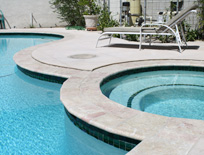Singing the Relief-Valve Blues

Let’s start this time with a key definition.
In the deepest part of a typical pool, you ordinarily carve out a two-by-two-foot box and backfill it with gravel. On top of that gravel sits a valve designed to open when the water pressure outside the shell is
greater than the pressure inside the shell — thereby allowing water that builds up around the shell to flow into the bottom of the pool. That device is known as a hydrostatic relief valve.
Hydrostatic relief valves are used to help prevent the possibility that when a pool is emptied for maintenance or service, pressure on the shell might build to such a point that even a concrete shell can pop up out of the ground. There is no more spectacular pool failure (except for having one roll down a steep slope), and it leaves the homeowners with a repair bill so monumental that they’ll do everything in their power to extract the cost from the builder.
In most cases, hydrostatic relief valves are installed when pools are located at the base of a slope where groundwater tends to collect or build up, or in areas known to have naturally high water tables. It’s an unpredictable risk in many cases, so lots of the engineers and geologists I know specify the valves for all pools as a simple precaution — better safe than sorry.
Scenario: I was called in as an expert witness to examine a project where saturated soil had caused decks around the pool to heave. The pool itself had not popped, but it was leaking so badly that the autofill system ran constantly and the soil around the pool was obviously saturated to the point where the decks were in jeopardy. Not only was it a leak, it was a big leak.
We found that the pool had been prepared for the installation of a hydrostatic relief valve, with the two-foot cube set beneath the sump of the main drain and the requisite two-and-a-half-inch pipe sticking up into the sump where the valve should have been but wasn’t.
It’s common in these projects to have the plasterer install the valve, which is just a small plastic device that easily attaches to the top of the standpipe. Sometimes, however, plasterers forget to take this step and then mask it by prematurely covering the main drain with its grate. It’s a careless mistake, and it’s exactly what happened in this case.
Effectively, the error left a large hole in the bottom of the pool, which is ironic because water flowing out of the relief line caused the problems we found instead of preventing them as intended.
The builder in this case had inspected the pool, recognized the problem, stuffed paper towels into the pipe and “sealed” it with duct tape (the universal bandage) and some plastic sheeting — a temporary fix while he went to find the right part. All would have ended well had he not forgotten to follow through.
More than four weeks passed before we were summoned to the site and found the paper towels, tape and plastic still in place and leaking like a sieve. It was simply not an acceptable long-term repair, and by the time the problem was corrected at last, the builder found himself swallowing a repair bill of more than $20,000.
Lesson Learned: Never just assume that a hydrostatic relief valve has been installed. Inspect the work yourself to make certain the device is where it should be — and while you’re at it, make sure it’s properly seated on the pipe or it will leak just as surely as if it was not there at all.
When critical portions of the work are left to other contractors or subcontractors, be sure to follow up and make certain everything has been done the way you want it to be. Again, make no assumptions!
Scott Cohen is president and supervising designer of The Green Scene, an outdoor design and construction firm based in Northridge, Calif. He provides consultation for clients nationwide and gives seminars on designing landscapes, swimming pools and outdoor kitchens. For more information, go to www.greenscenelandscape.com.










